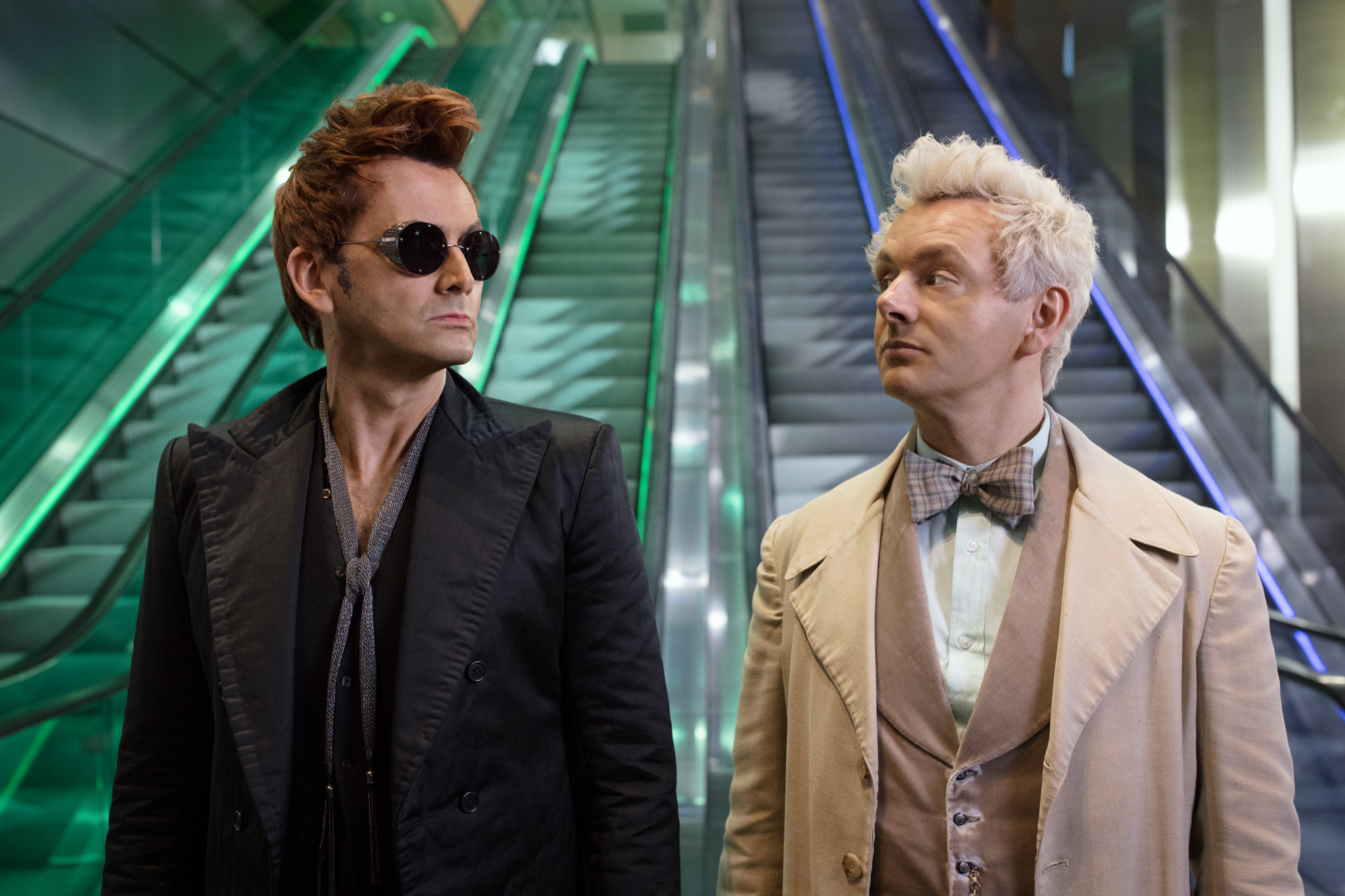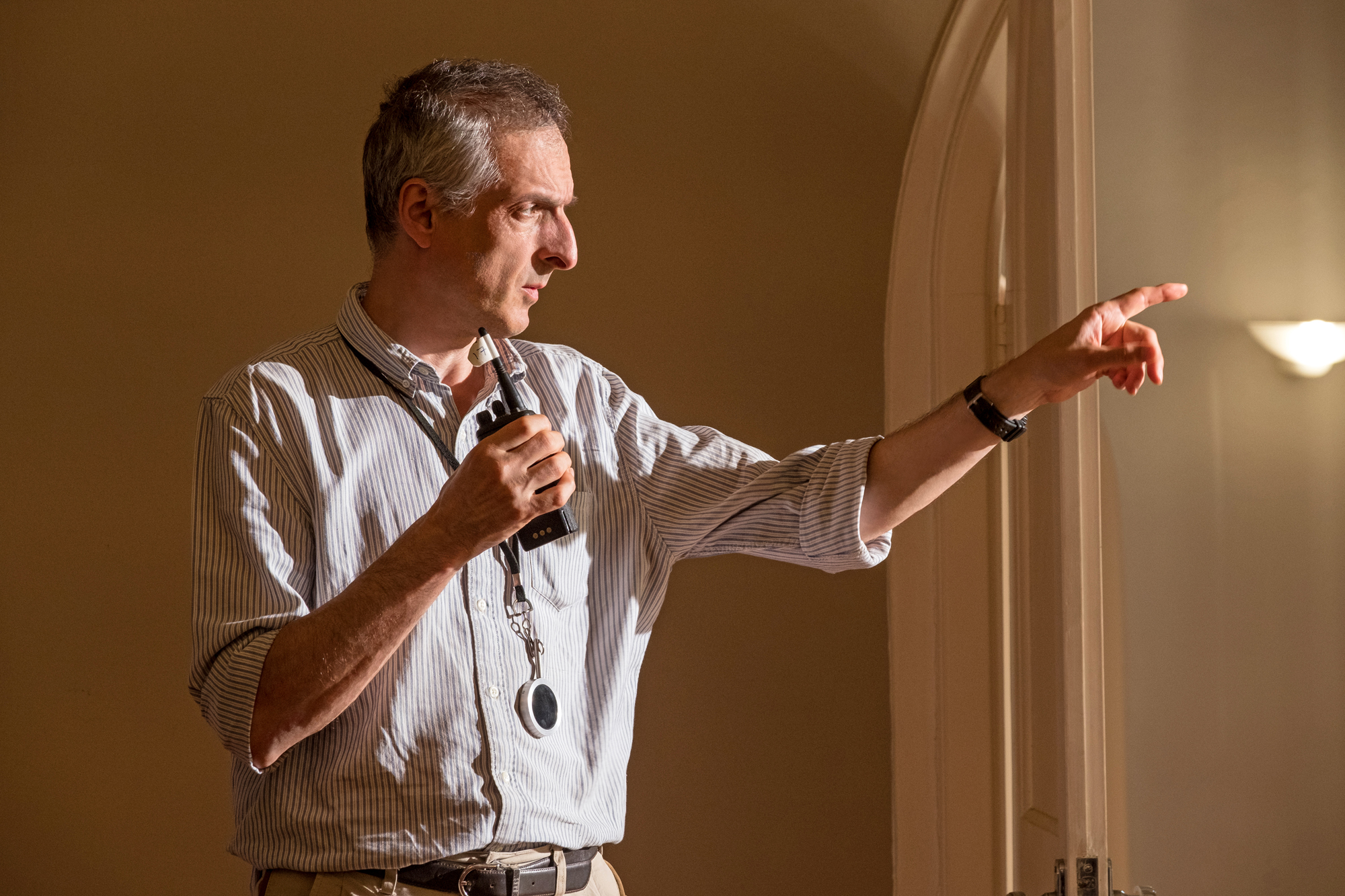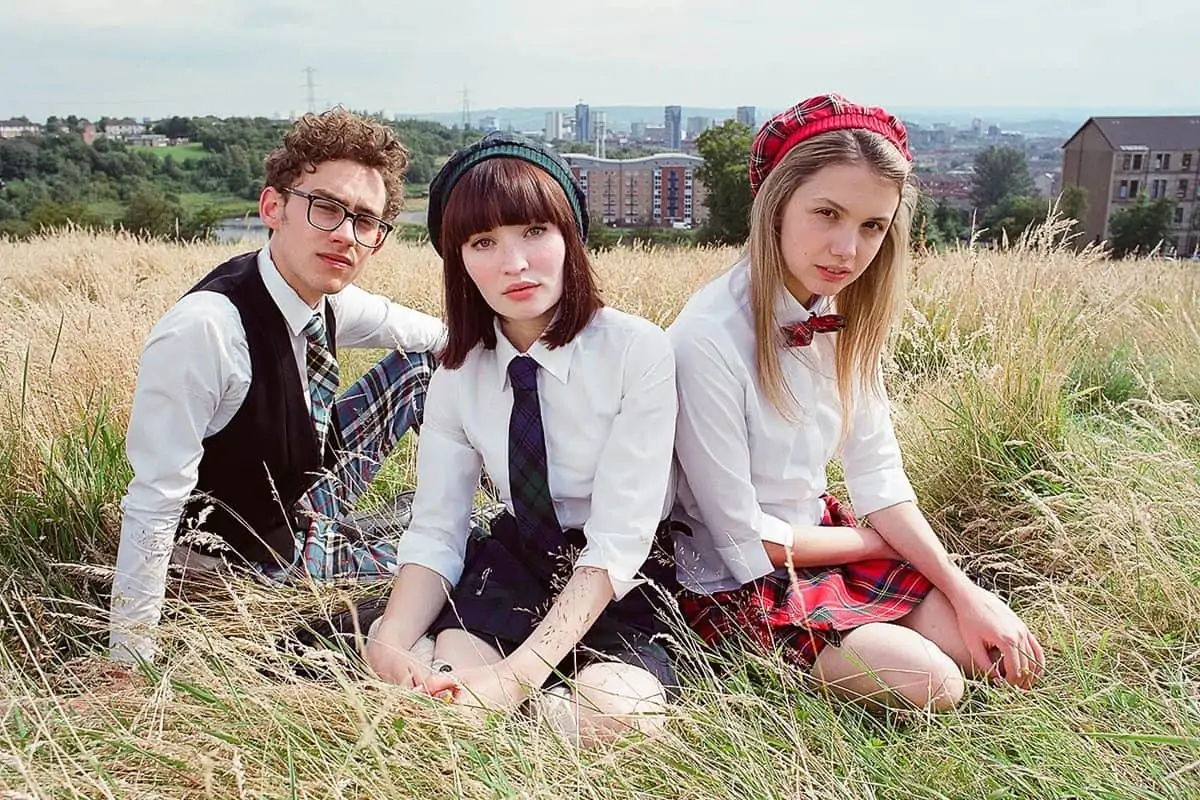Apocalypse Not Now
Gavin Finney BSC / Good Omens

Apocalypse Not Now
Gavin Finney BSC / Good Omens
BY: David Wood
As the end of time grows near with the approaching Apocalypse, an angel and a demon join forces to find a way to save the world. That's the premise behind Good Omens, the visually-energetic Amazon Prime/BBC co-production, based on Terry Pratchett and Neil Gaiman's collaborative 1990 novel Good Omens: The Nice & Accurate Prophecies of Agnes Nutter, Witch.
Gavin Finney BSC says his decision to accept the offer, from director Douglas Mackinnon, to shoot the six-part fantasy series was as fast as it was unexpected.
"I was sitting at BAFTA waiting for a meeting and ran into Douglas, who I'd worked with twice before, on the Billy Connolly film Gentleman's Relish (2001) and cycling film The Flying Scotsman (2006)," recalls Finney. "We always said we wanted to work together again and Douglas mentioned that things might be changing on his Good Omens project. A few days later I got an e-mail out-of-the-blue asking if I was still interested, as the DP initially slated to shoot the novel had to drop out.
"Douglas also asked if I could fly out to Cape Town the next day to recce the locations with the production designer Michael Ralph. I was already booked to shoot a commercial in Dubai, and about to make up my mind on one based in Hong Kong, but I didn't hesitate. Next minute I was back home packing my bags.
"I was delighted because Good Omens was right up my street. I had already worked on three other Terry Pratchett fantasy novels - Hogfather (2006), The Colour Of Magic (2008) and Going Postal (2010). I thought those might count against me - that they might be looking for a different view. But I think what counted in my favour was that I knew how to manage big stories with plenty of CGI, large crews and complex locations and sets."

Good Omens had a couple of advantages which made the shoot smoother and the production a lot more straightforward, recalls Finney.
First was that director Douglas Mackinnon had signed up for the whole six episodes, not always the case for big budget mini-series where two or more directors are often used. So there would be continuity of direction throughout.
The second was that the book's co-creator Neil Gaiman was showrunner and scriptwriter on the series. Pratchett famously wrote Gaiman a letter when he was in the final stages of Alzheimers Disease asking Gaiman to get the film made. When Pratchett subsequently died, Gaiman regarded Pratchett's request as a dying wish, and spent 18 months adapting the book into six episodes. "The key thing was that Neil wasn't overly slavish to the text, and was able to adapt the book and make smaller characters bigger as the film interpretation of the book required.
When you enter the comedy world of Terry Pratchett and Neil Gaiman, one's usual visual references are pointless, really. So the look doesn't reference anything else, it's more starting from scratch," explains Finney.
"I first spoke to Douglas about the look of the series on the flight out to Cape Town," he recalls. "What was immediately clear was that the scale of the project would be very big. And that the camera would never be static, but continuously moving. No static, wide, establishing shots, rather wide establishers mounted on a crane that's already on the move."
The emphasis on moving the camera was underlined by the 55 days of Technocrane ring-fenced in the budget from the outset out of a total of 105 filming days, which by the end of shooting had crept up to a total of 77 days of Technocrane. Two Steadicams were also used all the way through to inject a further sense of kinetic energy.
"Matt Fisher was our A-camera operator using a Steadicam AR rig which became part of the look of the film," says Finney. "The AR rig allows you to move the camera smoothly in the vertical axis - and Matt is a master at that, smoothly moving the camera up and down, enabling us to blend the Steadicam shots with shots from the Technocrane."


Adding to the hyper-energetic visual character of the film were the characters and props created by the imaginations of Pratchett and Gaiman, enhanced by the set design of Michael Ralph. That included a 1920s Bentley driven at 120mph through Soho Streets by Crowley (David Tennant), a flying moped, and the Four Horsemen Of The Apocalypse on motorbikes.
The look was best described as a "kind of hyper-real" says Finney. "If there was blossom in the Garden of Eden it had to be the blossomiest blossom on the best tree. Similarly the bookshop in London which forms the backdrop for one scene has to be the best ever bookshop.
"We continually asked ourselves throughout the film whether the locations were Good Omens enough? Was it interesting enough or did it have to be punched up in terms of the look?
"Even on some big shooting days, Douglas would allow the time to wait for the sun to be in the right place so that it all looked the best it could possibly be. Everything needed to have that energy from the get-go, which was totally liberating, energising and good fun."
The decision to shoot in 2.35:1 Cinemascope aspect ratio was unusual for a comedy, but it made sense for Good Omens, explains Finney.
"There are times when particular aspect ratios fit the locations, characters and the set designs really well. In this case we sometimes needed four or five children, a dog and Crowley all in the frame at the same time, so a wider aspect ratio made sense. After recces, I sometimes print out location stills in different aspect ratios to see how well it fits that format. What I do know is that you can't artificially impose an aspect ratio that doesn't fit, especially after you've shot it."

"There are times when particular aspect ratios fit the locations, characters and the set designs really well. After recces, I sometimes print out location stills in different aspect ratios to see how well it fits that format. What I do know is that you can't artificially impose an aspect ratio that doesn't fit, especially after you've shot it."
- Gavin Finney BSC
The series was shot in 4K UHD using spherical lenses and a combination of Alexa SXT and Alexa Mini camera systems, combined with Leica Summilux Primes and ARRI Alura zooms.
"The Alexa Mini made a lot of sense to use on the Steadicams, and we could use the Alexa studio cameras on the Technocranes," says Finney. "Of course, there are new cameras and new workflows coming in all the time, but on this shoot we selected the Alexa system as we were limited to just over 100 shooting days and needed a reliable camera that could handle deserts or rain, high-speed photography, and also have low noise in the blue and green channels to help with the approximately 1,200 CGI shots. There's no doubt that Alexa is very reliable. All the kit could be sourced both in the UK from ARRI Media and for the second half of the shoot in Cape Town from Media Film Service, and crews are familiar with the cameras. It's not much good having a new camera, which is hard to source, and no one knowing how to operate it."
In addition, for super slow-motion work, the production used the Phantom 4K Flex at 1,000fps and an ARRI D21 which was brought out of retirement and especially re-built by ARRI Media in the UK as a hand-cranked camera for a period sequence of a dance similar to a Gavotte.
"This is the only digital hand-crankable camera in existence, and you should've seen the faces of the South African crew when we shipped it out to Cape Town," Finney exclaims.
One of the challenges was the sheer complexity of the story, which has seen other attempts to adapt the project flounder." In one episode you go through twelve time periods," recalls Finney. "From the Garden Of Eden to Noah's Ark to 33AD to Ancient Rome to Medieval knights, Elizabethan England, Victorian London, the Blitz, the Swinging 60s, the 1970s, 2007 and the present day."
A key part of creating different period moods was the grade, carried out by Molinare colourist Gareth Spensley using Baselight.
"Gareth was fantastic," says Finney, "he had amazing creativity and energy and he couldn't do enough for the show. He was a key creative collaborator."
The process started with the rushes from the DIT Rich Simpson, which were given a series of looks using Film Convert, a film emulation software loaded into DaVinci Resolve.
"We had a present-day look, a 2007 look, a near-period look and far-period look using different Fuji stock emulations to help give each period a different feel, which would be the starting point for the grade, which Gareth would develop," explains Finney. "Tadfield - the home of Adam the Antichrist, for example - needed a very hyper-perfect look. It's a place where it's always snowy on Christmas Day, is always sunny in August and the flowers always bloom. Everything in Tadfield, which was shot on location in the Buckinghamshire village of Hambleden, had to be 'hyper'".


Sometimes the most difficult challenges on a shoot are not the most immediately obvious, says Finney. Shooting daylight exteriors of a bookstore set in a recreation of London's Soho, constructed at a disused airfield in Bovingdon during the middle of the British winter, for instance. Shooting started before it was light through to well after 7pm when it was dark again.
The trick of adding artificial light to compensate for the loss of daylight is to make it look seamless, something which gaffer Andy Bailey helped achieve.
"Andy's ever-cheerful, can-do attitude was very important to the success of the show," Says Finney. "We rigged the set with six six-metre 'hybrid' helium balloon lights, four x 18K Fresnels and mobile 20 x 20ft greenscreens mounted on Manitou fork lifts. Each had its own self-contained lighting rig which we could drive to wherever we needed it."
There were also several car sequences shot at West London Studios using Lester Dunton's video projection system, which enables the internal lighting effects in a car to be mapped to the external back projection, cleverly solving one of the most difficult things with shooting on greenscreens, namely matching internal and external lighting.
"With this system, everything marries up - so if a red bus goes past outside the car you see the effect of that bounced red light inside the car at the same time," says Finney. "Additionally, the actors can see where they are going. Lester shot all the driving plates for each scene and stabilised them before projecting them on set.
"We used this system a lot, it was particularly useful in car sequences where the cars go through huge walls of flame."
Other unusual sets included the recreation of heaven, lit externally through frosted glass windows using 77 SkyPanels linked to a dimmer system that could balance the output throughout the day and into night - shot on location near the Mercedes Benz Experience which provided massive open office areas which the production design department were able to turn into a realisation of heaven.
Milk VFX based in London delivered the CGI for Good Omens, also providing VFX supervisor Jean-Claude Deguara, and technical director David Jones, who were present for virtually every day of filming.
"On something as complex and new as Good Omens, everything has to be worked out almost from scratch, new digital assets constructed, and every filming trick in the book utilised. We employed drones, helicopters, motion-control, cranes, tumble-rigs, ultra slo-mo cameras, interactive lighting systems... you name it. The result is over 1,000 VFX shots seamlessly integrated into six hours of high-energy story telling," concludes Finney.




